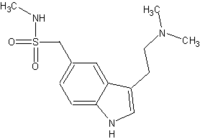CHICAGO--The first prospective trial pitting an over-the-counter product against a prescription medication gave the edge to the OTC product for the earliest treatment of migraine headache.
Results of a multicenter trial showed that acetaminophen/aspirin/caffeine (AAC) provided more rapid, significantly better, and more sustained relief than sumatriptan when taken at the first sign of a migraine, Dr. Jerome Goldstein reported at the annual meeting of the American Headache Society.
Both treatments are first-line therapies for migraine according to U.S. Headache Consortium guidelines, but Dr. Goldstein cited a lack of comparative data and a general assumption that a prescription drug is always better than an OTC agent.
Unlike many previous studies of headache pain, this trial focused on starting treatment at the earliest sign of a migraine. "Early treatment--and this has been a complaint of many in the headache field--represents, if you will, the real world where we are every day of our lives, rather than a clinical trial setting," said Dr. Goldstein of the San Francisco Clinical Research Center.
In the double-blind, single-dose study of 171 patients, 69 were randomized to AAC (acetaminophen 550 mg, aspirin 500 mg, and caffeine 130 mg), 67 received sumatriptan 50 mg, and 35 received placebo.
All patients met International Headache Society criteria for migraine, and 54% reported a history of severe disability. At baseline, 27% had mild pain, 72% had moderate to severe pain, 68% had activity limitations, 93% had photophobia, and 79% had phonophobia. About 60% had used OTC medications as well as prescription medications.
Patients treated themselves at the first sign of a migraine. They recorded pain intensity (0=none, 1=mild, 2=moderate, 3=severe) and disability, as well as the presence of nausea, vomiting, photophobia, and phonophobia, at baseline and after 15, 30, and 45 minutes and 1.0, 1.5, 2.0, 3.0, and 4.0 hours. The primary end point was summed pain intensity differences from baseline over the 4 hours (SPlD4). SPlD4 was defined as the level of pain intensity before treatment minus pain intensity at a series of assessment points. The patients also rated pain intensity and treatment effectiveness after 24 hours.
At 30 minutes, a significantly greater proportion of sumatriptan subjects (29%) rated their pain as reduced to mild or none, compared with patients treated with AAC (19%) or placebo (6%).
But at 2 hours, a significantly greater proportion of AAC subjects (84%) rated their pain as reduced to mild or none, compared with subjects who received sumatriptan (65%) or placebo (52%).
At 4 hours, AAC was significantly superior to sumatriptan and placebo for summed pain intensity difference (3.9, 2.1, and 1.8, respectively) and for total pain relief (8.9, 6.9, and 5.7, respectively).
Patients treated with AAC had meaningful relief 32 minutes earlier than sumatriptan patients and 145 minutes earlier than placebo patients. These findings were different from headache response, in which sumatriptan was superior at 30 minutes.
At 4 hours, fewer subjects in the AAC group (1.5%) required rescue agents than in the sumatriptan group (11.9%) or the placebo group (14.3%). There was no significant difference between groups in recurrence rates among patients who had mild or no pain at 2 hours and then advanced to moderate to severe pain at 24 hours.
There were no serious adverse events in the study, but AAC subjects were more likely to report gastrointestinal upset (21.7% vs. 7.5%, respectively.) Dr. Goldstein received a research grant for the study from BristolMyers Squibb Co., manufacturer of Excedrin Migraine.
COPYRIGHT 2003 International Medical News Group
COPYRIGHT 2003 Gale Group



